Blackstock Ranch
The History of the Squaw Creek Ranch. In 1866, W.F. Sommercamp and cowman Patrick Doyle drove a herd of horses from California to the Squaw Creek area. They set up a cattle and horse operation near Opaline. One of the older deeds of Idaho land signed by President Grant was held by Sommercamp in 1872. The first recorded owner of the Squaw Creek Ranch, about two miles from the Snake River, and the earliest land patent discovered was dated November 20, 1877.
The creek was named for two reasons, one being there was an Indian campground on the head of big Squaw Creek where the Indians came each year. Another was that two squaws were killed somewhere on the upper creek. This supposedly was done by the Indians as the squaws were never buried.
Among the earliest settlers in the area were the Chinese. They developed a plot of rich level land along the south edge of Squaw Creek known as the China Gardens. As the creek would dry out in the hot summer months, the Chinese were prepared as they had dug a ditch from Mud Springs about two miles away to bring additional water to their gardens. They harvested the produce and transported it by hand cart to Silver City to be sold. With running hot and cold water, this area was not only known by the native inhabitants but was recorded as a reference point to give directions to travelers.
Sommercamp had a ranch on the lower Squaw Creek and on Cow Creek where his outfit summered, running mostly horses. He also brought some Durham cattle and had Carl Brunzell herd them. Carl stayed in a cabin above the upper creek, where he had found the squaw skulls and hung them on the end of the cabin. Carl, unaware of the trouble brewing, told of seeing distant Indian tracks around but didn’t think anything of it.
Legend has it that during an Indian uprising the ranch hands left the lower area for a short time to seek shelter. The Indians, while on their war path, burned the orchards known as The China Gardens except for one spindly sprout that was too small to attract their attention. Questioning why Carl’s cabin was not burned, most tribes believed that the souls of the dead pass into a spirit world and become part of the spiritual forces. They feared the ghosts of the deceased. Carl strongly believed that those skulls ended up saving his life.
About that same time in Johnstone, Scotland, Joseph and Jane Blackstock lived with their large family. One of nine children, Adam Blackstock was born in 1864. Adam emigrated to the U.S. in 1889, and made his way to Idaho from the east coast by railroad. In order to come to the United States, an employer had to sponsor the person seeking work for their company. In turn, Adam worked in the Demming Mine south of Silver City until the lodes were exhausted and the mining company failed to pay him. Blackstock then herded sheep for John McMahon on the Malloy Ranch, sheep outfit on Succor Creek along the Oregon/Idaho border.
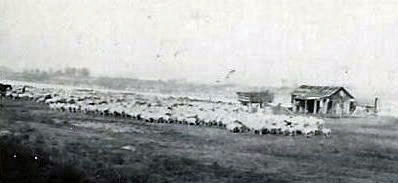
In 1890, Adam started to work for a prosperous sheep man by the name of John Drennan who offered Adam a deal to operate a band of sheep on shares. Adam, as operator, would run the sheep, doing the work and paying expenses. Drennan as owner would receive the wool money and the ewe lambs and Adam, in return, would receive the wether lambs and a band of sheep. In three years Drennan had his ewes replaced and was receiving the profits of the wool and Adam, as operator, now had a band of sheep of his own. A band is roughly a thousand head. Adam wintered in a dugout near Sucker Creek during this time period.
An accident on August 7, 1890 claimed the life of Sommercamp when he fell into a mining shaft. The family retained ownership of the ranch for several years, but on January 16, 1892 the following advertisement began to appear in the Avalanche: For sale: Known as the Sommercamp & Co. Ranch situated on Squaw Creek and Cow Creek Owyhee, County. Deeds show Judge Charles M. Hayes purchased the ranch on October 22, 1892 for his son in law Meserve Merrill Getchell to run. After a year, Getchell didn’t like ranching and ended up leasing the ranch to Adam.
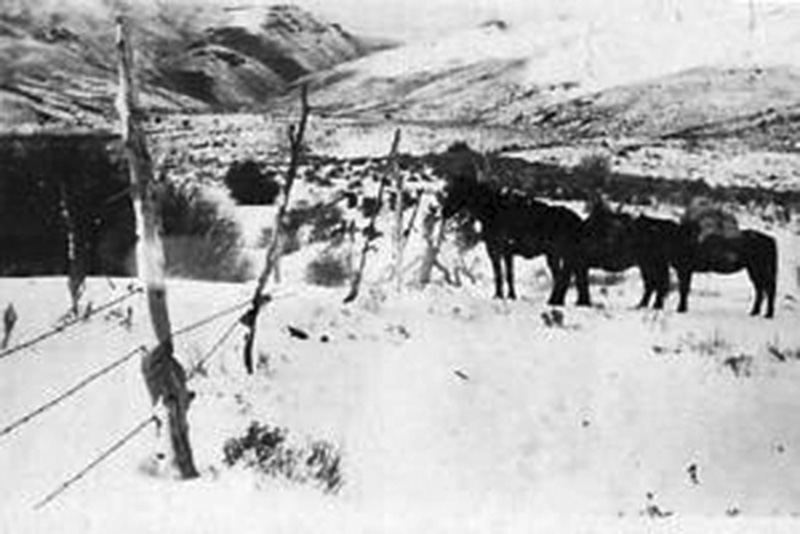
In 1892, Adam borrowed two $20 gold pieces and bought another band of sheep growing to several thousand. Adam and his two brothers Joe and Herbert, listed in the “Commercial directory” as wool growers, resided in a cabin in Rockville, Idaho. The $40 debt, which then seemed a substantial sum, was repaid in three years “by living rather frugally.”
Sommercamp had built corrals and fences around the orchards made of large sandstone blocks. On June 9, 1894, a cloud burst over the Owyhee Mountains brought a torrent of water down Squaw Creek and the flood carried away the surroundings of rocks up to a half mile away.
In 1898, Adam Blackstock and Johnny Bruce formed a sheep partnership. On May 26, 1899, they sold 50,000 pounds of wool at 11 cents a pound, as recorded.
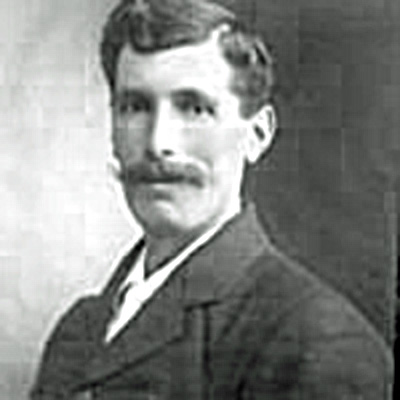
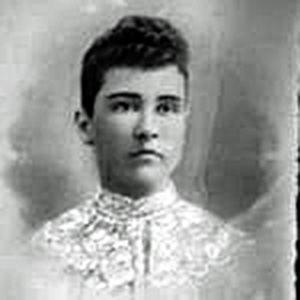
In 1900, Adam traveled to Salt Lake City, Utah to make funeral arrangements for his brother Hubert’s burial. There he met and married Mary Jane Napper and returned to Idaho accompanied by his new wife and her father John Napper.
1901 – The beginning of Blackstock Ranch: Adam & Mary J. Blackstock; Adam H. & Mildred Blacstock; Ted K. & Mary L. Blackstock; and, Ted S. & Mary L. Blackstock. Herding sheep around the range, Adam’s interest was drawn to the Squaw Creek area. Adam borrowed $6,600 dollars from Mrs. A.J. Sands, a wealthy widow from Silver City. On February 1, 1901, the Sommercamp property became the Blackstock Ranch, thus beginning a family tradition. Adam moved his sheep and range cattle for the next several years. Adam developed the ranch and a herd of purebred Aberdeen-Angus cattle. In addition, he bred and raised draft horses. Blackstock Ranch House Blackstock Barn
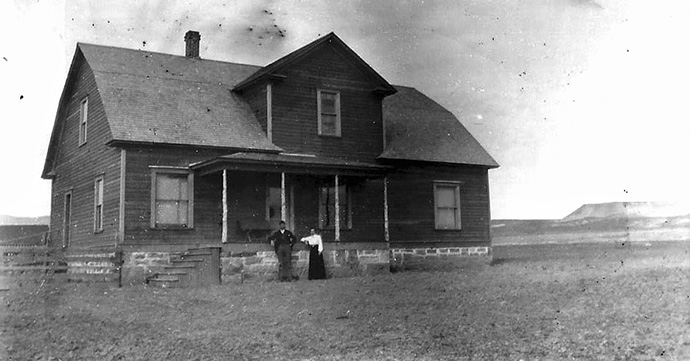

Adam, Mary & John lived in a tent for two Iyears while building their home. The sandstone blocks that had washed away were gathered and Adam used them to build foundations for buildings on the ranch. A date of 1892 is etched in a block on the two-story ranch house. Various out buildings and barns of Blackstock Ranch were built and completed in 1905, yet the link to the ranch of earlier times is that spindly “growing” sprout — a Black Walnut tree.
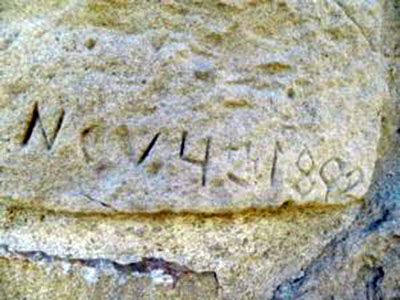
Two children were born to this union. Mary traveled by train and Adam H. Blackstock was born December 15, 1908, at Salt Lake City, Utah, followed by Lucy in 1915. Both were raised in the Opaline area and attended school in a one-room school house located about 1.5 miles east of the family ranch.
In 1915, Adam sold his purebred herd of Angus cattle that consisted of 80 head of cows that fetched $125 dollars a head. An additional one bedroom bunk house was built on the ranch in 1917. Adam served as an Owyhee County Commissioner in 1919-1923 and, again, in 1928-1930.

Prior to 1920, traveling mainly by horseback or horse and buggy, Owyhee County residents had to cross the Snake River by ferry boat. During that time bridges were being constructed across the Snake River at Homedale, Marsing, Walters Ferry and Grand View and, in 1923, the railroad was extended into
Marsing. Adam H.
Caldwell High School and followed his father’s ranching traditions. He met Mildred J. Wissell (Wissell Farms, Nampa, Idaho) while she boarded at the Clark’s residence about a quarter mile from the Opaline school house. Being a rural area, single women did not live alone unless there was a teacherage at the school (Dorthay Tindall). Mildred became a teacher and was hired at the Opaline School. She taught there on and off for 33 years.
Adam H. and Mildred married on June 6, 1931. Mildred had to quit her job, as school teachers could not be a married women. This policy changed a few years later. From this union three children were born. Ted K. Blackstock in 1934, Elaine in 1937, and Dianne 1944. The five of them lived in the one bedroom bunk house until 1949. In those days, kids often slept in cribs until six years old. In fact, they were called “6 year cribs”.
Adam #1 died January 14, 1955. At the time of his death he was the oldest taxpayer in Owyhee County.
The Great Depression of the late 1920’s and early 30’s was a tough time for the people in the Owyhee County ranching community and in 1931, the bank foreclosed on the first generation sheep operation because of a $2,880 dollar debt. The adjoining ranches of Cow Creek and Walker were sold but the family was able to keep the original homestead. The Squaw Creek was used for irrigation but generally would go dry the end of May during the hot summers, limiting the crops. A severe drought without rain in 1934 didn’t help and Blackstock was only able to irrigate three acres.
Ted K., Elaine and Diane attended school in the same one-room school house in Opaline until the school closed and students went to Marsing in 1961.
In those tough times, John Archabell of Jump Creek Sheep Company had purchased small homestead acreages throughout the Owyhee area. Adam H. lived on the family ranch and grazed sheep and cattle. The Archabell range was intermingled with Blackstocks private ground throughout. Archabell wanted to retire and approached A.H. Blackstock to purchase the land. This was something that none of the ranchers could afford but since the range was an important part for the ranching area, Adam went to the FHA (Farmers Home Association) to seek loan approval and approached surrounding ranchers to form the Chipmunk Grazing Association. Memberships and grazing shares were paid which made the FHA land payments. This was his main interest and what he worked to protect. Following the same path as his father, Adam H. was also involved in politics. He served as an Owyhee County Commissioner from 1943-48; State Senator from 1949-58; secretary-treasurer of the Opaline Irrigation District for 40 years; a member of the Owyhee County Fair Board; Owyhee Cattlemen’s Association and secretary-treasurer of the Chipmunk Grazing Association.
In 1952, Ted K. graduated and immediately joined the Air Force. He was stationed in West Palm Beach, Florida but spent the summer months electronically charting the Arctic from Baffin Island to Norway during the Korean conflict. Ted met Mary L. Cain at a drive-in picture show. They dated until he left the Air Force and moved to San Francisco to attend college and become an architect. Mary followed him to San Francisco. As Ted K. wrote, and would chuckle every time he’d talk about it, “While chewing on a toothpick,” he realized he wasn’t adaptable to civilization so he returned to Idaho with Mary. As they topped the hill overlooking the sage brush and ranch, the Waterloo, Iowa girl was not impressed and cried.
Living in the one bedroom bunk house, five children was born to this union. Ted S. in 1960; Barbara in 1961; Matt in 1962; Gwen in 1964; and, Joe in 1965. In 1969, they moved into the big ranch house and welcomed the added room. Ted K. farmed what he could on the ranch but with the limit of water he also farmed an additional place in the Opaline area.
In 1965, Ted K. developed a river pumping station from the Snake River one and a half miles north of the ranch. Water was lifted 180 feet to an irrigation ditch towards the ranch for gravity flow production. There was enough to raise hay for the livestock so they didn’t have to purchase feed. They grazed about 500 Hereford cross cows and 200 yearlings. Ted wrote, our biggest problem is a torrent of federal regulations and lawsuits brought by the “greenies”. In the nineties Ted K. started a small herd of registered red Angus. Family genealogy was also an interest of his until his death in 2005.
Already operating the ranch, Ted S. had his cow herd started. Needing breeding bulls he attended the Foote’s bull sale where he met Mary L. Murkowski while working the sale. They married June 14, 1986 and had two children. Tyler S. in 1991 and Katelyn M. in 1993.
On April 2, 1989 an article about the life of Owyhee County rancher and former Politician Adam H. Blackstock was published in the Idaho Press Tribune, just nine days before his death on April 11. Hearing about Adam’s knowledge and stories, we were reminded of the large void we felt after his passing.
The very large black walnut tree was a conversation piece as people would come to the ranch to visit. Over time, though, it was beginning to show its age. Through the years the one and only kept hanging on and many efforts were made to start and plant a new tree. These failed, dying out in 2009. Hopes of starting a new tree was given up along with the feeling of some history lost, but in 2010 from under the old saddle house a new sprouted black walnut tree emerged — as though the old tree had a mind of its own.
Through the years weather took its toll on the ranch house and the original wood shingles, or lack thereof, were not keeping the elements out. In 2013, the steep pitched roof was replaced. Additional hazards for the men being anchored by a rope to the chimney was the unbelievable amount of wasp protecting their home! As the last section of the roof was being put on they noticed five names written on a beam: Ed Smith, Ed Muller, Chuck Miller, Beu Hart and Allabaugh with a date of October 21, 1905.
In 2013, while on vacation the Sevy family, Opaline area neighbors, visited the National Cowboy & Western Heritage Museum in Oklahoma City. On the floor of the 8,000 square foot building is a large granite map of historical ranches in the United States. One of the stars on the state of Idaho is the Blackstock Ranch.
fsBeing the fourth generation, Ted S. & Mary Blackstock, continue to operate the family ranch. Running mainly, Black Angus cross cows. Sagebrush has been cleared over the years and pivots have been installed for more efficient irrigation and improvements to the farm ground of 650 acres in production along with extra feed to sell.
Ted S. has served on the Owyhee Cattlemen’s Association board and as President in 1993. He also served as Owyhee County Farm Bureau treasurer; on the Idaho Farm Bureau Beef committee; Natural Resource committee; and Chipmunk Grazing Association. Ted S. has worked to keep the ranch together and to protect the western ranching and grazing traditions. This is becoming more complex as government continues to over regulate by taking grazing AUM’s and water rights as they follow the agendas of environmental groups that want to end all grazing. We provide and care for the land to ensure it remains viable for generations and we end up defending our heritage in order to stay in business. It’s a lifestyle and beauty that needs to be fought for along with the historical events of these ranches.
In the spring of 2014, an Indian youth named Ethan Thomas came looking for work. He was hired. With no prior discussion the first day he mentioned his “kin” (3 X great grandfather) burned this place down and now I’m working for you. Who would’ve thought?!
The outside sandstone foundation of the 1917 bunk house is still sturdy. An amazing feat considering how it was built back in the day. No one had lived in the house for 25 years, but in 2015 we began restoring the bunk house.
In 2015, the Blackstock Ranch’s federal grazing permits along with 67 other permittees in the southwest corner of Owyhee County had gone up for review toward the renewal process. As the environmental groups clog the court system with endangered species claims, rather than challenge them it is easier for the BLM to cut the “Owyhee 68” permittees by 50% without gathering the facts of solid evidence of the health of the range lands. An abundance of grass is left.
On August 11, 2015, a lightning strike started the Soda Fire. One of the largest fires in Owyhee County history burned 278,344 acres of prime range land. High winds fanned the heavy fuel load and there was just time to get the gates opened. Sweeping across the entire upper hills where cows were grazing, the fire advanced towards surrounding homesteads, burning cabins and corrals. The fire jumped the Sommercamp road and 45 mph winds ran flames onto the ranch threatening the old structures. Thankfully, they were saved. One hundred percent of the Blackstock range along with surrounding allotments burned. It was not until the fifth day that we were able to saddle up and look for cows. As the range recovers for at least the next two years and depending on BLM grazing plans, pasture will need to be found for many cows. Ranching has its ups and downs and we want to keep this historical ranch viable to hand down to the fifth generation. Tyler and Kate will face uncertainties just like the generations before them. One of the biggest that they and many other ranching families in Idaho will face continues to be government agencies and their decisions. For now, defense is the plan.